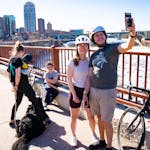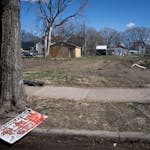Local elections often have a tough time drawing voters to the polls, but that wasn't the case Tuesday in Minneapolis or St. Paul.
In Minneapolis, election officials had to order more ballots after more than 20 precincts began running low because of higher than expected turnout, said Minneapolis City Clerk Casey Carl. Election officials estimate that 43 percent of the registered voters turned out at the polls Tuesday, up from 33 percent four years ago, Carl said.
"That's a really good turnout," he said. "That's on par with 2014 midterm elections. … People are turning out everywhere throughout the city."
The draw in part could be some competitive races in Minneapolis, Carl said. Sixteen candidates were vying for mayor in Minneapolis.
"I feel like voting at the local level is really an important way to make a difference, particularly with the national political scene," said voter Elizabeth Erdahl, one of 400 people who had voted in the Lynnhurst neighborhood by noon. "And I'm ready for a change in who our mayor is, so that motivated me quite a bit."
At Heltzer Manor high-rise in Minneapolis' Third Ward, head election judge Gwen McMahon hoped an evening voting surge would push turnout toward 40 percent. The precinct — one of the city's smallest with 826 registered voters — had surpassed 30 percent turnout by midafternoon.
Even before the polls opened Tuesday, nearly 12,000 Minneapolis voters cast their ballots early, Carl said, a dramatic increase from 2013, when 4,954 voted early.
"That is easily a new record for an off-year election, and was comparable to an election year when there is a statewide race or a congressional midterm," Carl said.
Voting also was heavier than expected in St. Paul where a field of 10 candidates competed to succeed Mayor Chris Coleman who is running for governor. A record number of early voters cast absentee ballots — 6,213, according to Ramsey County Elections Manager Joe Mansky. And by the time voting ended Tuesday, 61,876 people had voted — 27 percent of the city's eligible voters. That's higher than normal, Mansky said.
At Franklin Middle School in north Minneapolis' Fifth Ward, chief election judge Leah Proctor characterized the turnout as about average. "I wouldn't say that we're bumped up in the numbers," Proctor said.
Both Minneapolis and St. Paul use ranked-choice voting. Voters could rank up to three choices in Minneapolis and up to six choices for each office in St. Paul. A winner is declared once a candidate has received a majority of votes (or gets more votes than the only other remaining candidate).
If no one wins a majority in the first round, officials reallocate votes in a series of elimination rounds. Minneapolis will begin tabulating second- and third-choice votes Wednesday; St. Paul will begin Thursday.
Minneapolis Mayor Betsy Hodges faced 15 challengers, including state Rep. Raymond Dehn and City Council Member Jacob Frey. The entire Minneapolis City Council also was up for election.
In St. Paul, Melvin Carter surprised the field, becoming the first black mayor in the city's history on the first ballot. He topped second-place finisher Pat Harris with more than 50 percent of the vote. Dai Thao, Elizabeth Dickinson and Tom Goldstein finished third through fifth.
Voters said concerns about racial disparities and police-community relations influenced their votes.
Star Tribune staff writers Eric Roper and Liz Sawyer contributed to this report.
James Walsh • 651-925-5041
Mary Lynn Smith • 612-673-4788




